Bagley class Destroyers (1936)
 Fleet Destroyers (1935-48):
Fleet Destroyers (1935-48):
USS Bagley, Blue, Helm, Mugford, Ralph Talbot, Henley, Patterson, Jarvis DD-386-93
The Bagley-class destroyers were a group of eight destroyers built for the United States Navy during the 1930s. They were designed to serve as multipurpose warships capable of conducting a wide range of missions, including anti-submarine warfare, convoy escort, and surface combat. The Bagley class was ordered under the 1934 Naval Act, part of a series for the United States Navy in the late interwar, Following the Farraguts, Mahan and Gridleys. The ships were named after naval officers who had served during the American Civil War and the Spanish-American War.
They saw extensive service during World War II, all eight seeing action in the Pacific theater. They were involved in most operations and battles of the time including Midway, the Guadalcanal Campaign, Philippines and Leyte Gulf, Saipan, iwo Jima and Okinawa. Although lacking AA they Bagleys they proved to be rugged and reliable and screened their assigned carriers effectively.
After the war, the Bagley-class destroyers were rapidly decommissioned and scrapped. None were preserved as museum ships, although artifacts can be found in various naval museums around the United States.

USS Patterson in 1944
The Bagley class were a direct follow-up of the Gridley, the only admiralty design of the FY1934 programme, and largely identical, but with eight built in four separate yards, and considered generally less flimsier, but also heavier and slower than the Gridleys. They were built at Norfolk, Boston, Mare Island and Puget Sound. Bagley, Blue, Helm, Mugford, Ralph Talbot, Henley, Patterson and Jarvis like the Gridleys saw the toughest combats in the Pacific, being present in critical raids and operations, with USS Blue, Henley and Jarvis lost in action. Still, they earned collectively 70 battle stars. #ww2 #pacificwar #guadalcanal #battleofleyte #usn #usnavy #destroyer #bagley
Design of the class
Reconstructed plans, USS Blue.
The Mahan class represented, in effect, an attempt to achieve maximum des troyer gun battery at the possible expense of torpedo battery; it was alleged, for example, that the raised centreline torpedo tube might well be ineffective in combat. Before any Mahans had been completed to test this view, a new destroyer class was designed, trading one gun for a fourth bank of torpedo tubes. The resulting ship still had a broadside of only eight tubes, but by 1936 it appeared that torpedoes could be set to turn through wide angles after launch, so that a single ship could fire all sixteen torpedoes in a single heavy salvo.
These ships fall into two groups: Bethlehem Steel built four Gridleys (DD380 , 382 , 400 and 401) and the Navy Yards built eight Bagleys (DD386–393). It appears that the former were much flimsier, perhaps for higher speed (for which bonuses were paid); they alone of modern US destroyers received no 40mm guns in wartime, only (ultimately) 8-20mm. All ships has 2 DC racks. Trials figures were 47,265shp = 38.99kts at 1774t (Gridley), and 47,191shp=36.8kts at 1969t (Blue). In 1945 all four Gridleys lost two TT banks upon re-assignment to the Atlantic Fleet. The Bagleys, on the other hand, were fitted with a twin Bofors aft, plus 6-20mm, without loss of other armament, prior to the emergency AA refit programme of 1945, when all four TT banks would have been removed. The emergency battery envisaged, 2 quadruple and 2 twin Bofors, and 2 twin 20mm, was not fitted to any of these ships.
Hull and general design
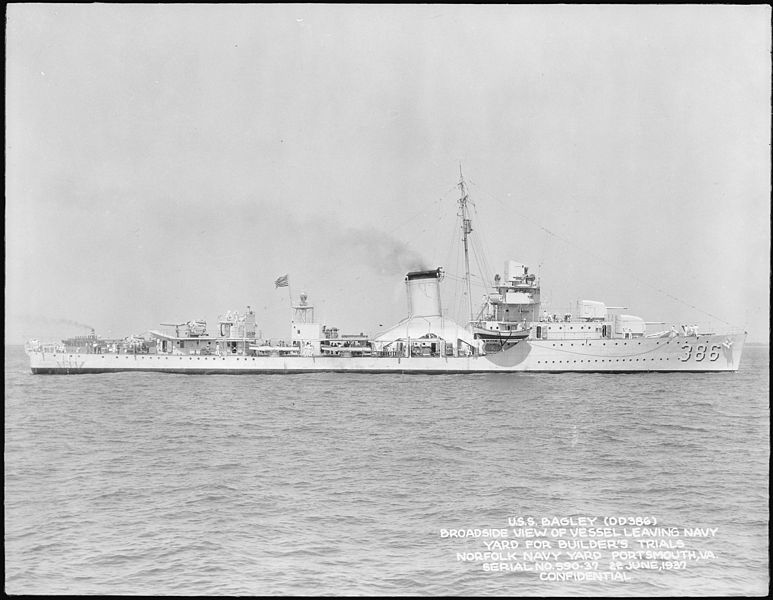
USS Bagley before the war, starboard side, showing the extensive truncating to the single funnel.
The hull of the Bagleys was a near-repeat of the Gridleys, but with more fuller shapes: They appeared overall less “flimsy” than the Gridleys: They reached 341 ft 8 in (104.14 m) overall, versus 340 ft 10 in (103.89 m) so about the same lenght than the Gridleys, but were slightly less beamer, at 35 ft 6 in (10.82 m) versus 35 ft 10 in (10.92 m) but with higher draft, at 10 ft 4 in (3.15 m) light and 12 ft 10 in (3.91 m) fully loaded, versus 12 ft 9 in (3.89 m) and fuller hull forms, as well a reinforcements. They were less plagued by stability issues than the Gridleys overall.
This traduced into a greater displacement, 1,407 tons (light), for speed trials, 1,624 tons (standard), and 2,245 tons fully loaded versus 1,590 tons standard and 2,219 tons full load. Speed, expectedly was believed to be a tad slower, notably because they did not used the same powerplant as the Gridleys, from bethlehem, but those of the Mahans, made more for fuel economy (and thus range) than speed.
Armament-wise they were a repeat of the previous Gridleys, without change. Design-wise also, with the same standardized appearance, single large funnel, tall bridge with glasshouse and fore control on top, single mainmast aft of it, extensive superstructures with gaps leaving some leeway for the broadside torpedo tubes banks.
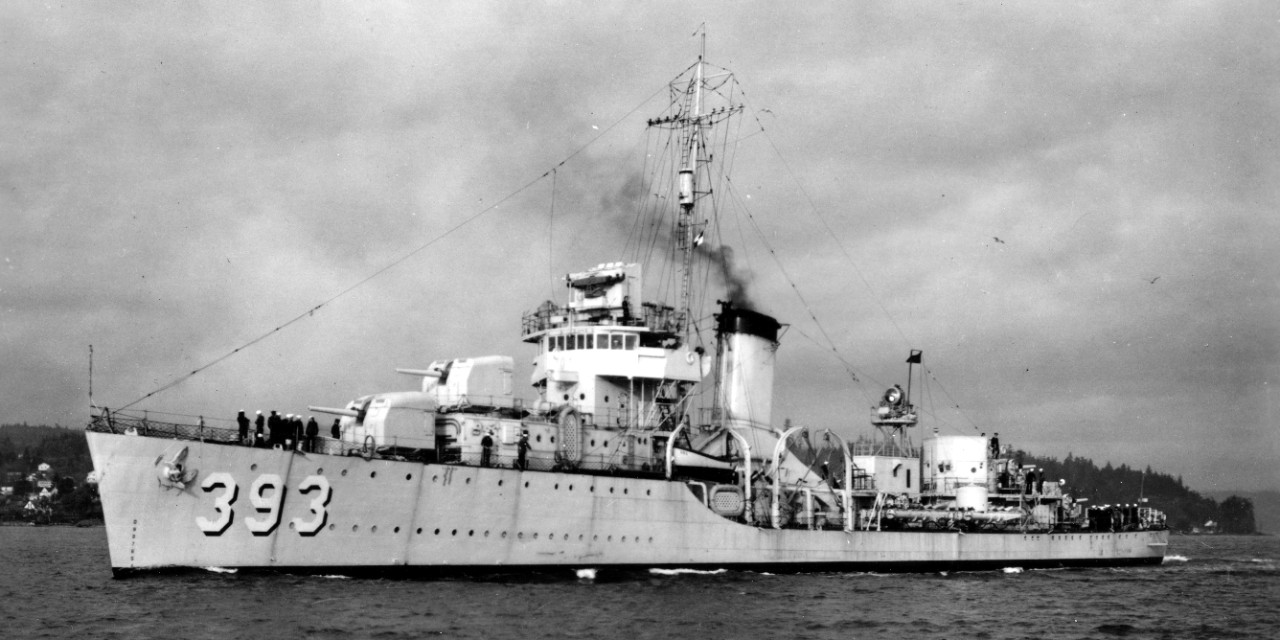
USS Jarvis in 1938
Powerplant
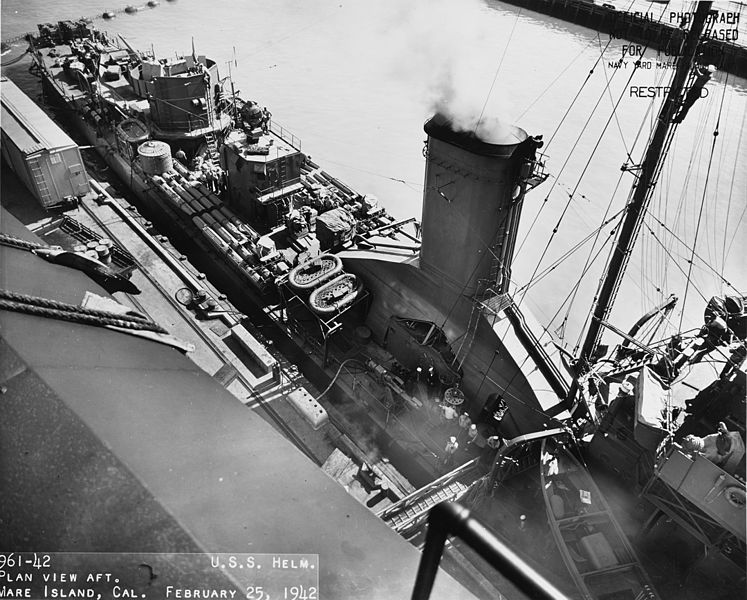
USS Helm’s funnel and trunctated exhausts.
In short, to situate the Bagleys in this 22-destroyers serie, they were a Navy design (Admiralty Board) duplicating the Mahan class machinery for better range, having prominent boiler uptakes and single stack whereas the Gridleys were a proposal from by Bethlehem Shipbuilding with advanced high-pressure boilers for better speed at the cost of range. The Benhams were a Gibbs & Cox design and just had a new boiler design enabling three boilers, and same efficient as the Mahans. They were considered overall the best of the three.
The Bagleys class propulsion plant repeated the Mahans design, with a boiler’s exit steam pressure of 400 psi (2,800 kPa) and 700 °F (371 °C) improving fuel economy, augmented by boiler economizers and double reduction gearing as well as cruising turbines. All these combined to produce a better range at 6,940 nmi (12,850 km; 7,990 mi) at 12 knots (22 km/h; 14 mph). This was 1,400 nmi (2,600 km; 1,600 mi) better compared to the Gridleys, which appeared “fast but short-legged”.
This two main geared steam turbines whatever the yard, came from General Electric. Each was subdivided between a high-pressure (HP) and low-pressure (LP) units, feeding into a common reduction gear. Steam was provided by four Babcock & Wilcox boilers, feeding first the HP turbine, exhausted in turn to the LP turbine, which exhausted to a condenser. These LP cruising turbines were geared to the HP turbines in such a way thay could be engaged or disengaged and enabled better efficience at low speeds, producing considerable fuel economy.
All told, they produced a tad less output than the Gridleys at 47,200 shp (3,000 shp less) still managing a nominal 36.8 knots (68.2 km/h) on trials. None reached the blazing speeds of the Gridleys. The 42 knots demonstration by Bethlehem was mostly a way to get bonuses.
Armament
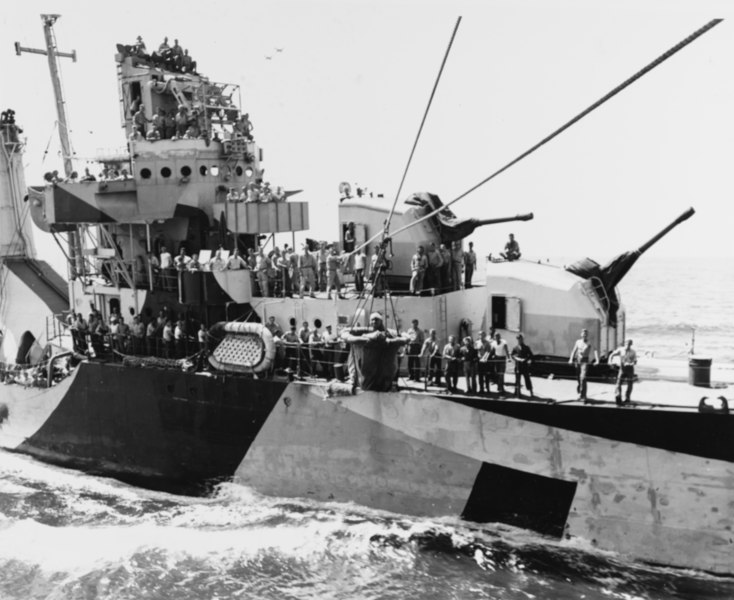
Forward battery of a Bagley class ships escorting USS Enteprise, 16 June 1944.
The Bagleys were similar to the Gridleys and Benhams for this arrangement “torpedo-first”, with four 5-inch (127 mm) dual purpose guns in single mounts, two forward, two aft in superfiring positions, and diverging as for the Gridleys in two forward fully enclosed Mark 25 mounts and two aft shielded Mark 21 mounts.
Their ace card and mainn assets were the same impressive sixteen 21-inch (533 mm) torpedo tubes arrangement in four quadruple mounts, two per broadside facing each others. They also had a very weak AA armament in 1941, soon augmented by 20 mm Oerlikon guns when available. They lacked 40 mm Bofors but for a few ships. ASW was also a duplicate of previous Gridleys, with two dephjt charges rackes later completed by four to eight Y-Guns. Fire controls were the same and radars, sonars were also added later.
Main: 4x 5-in/38 Mark 12

Mark 25 forward fully enclosed mount for the Mark 12 38-caliber 5-in gun
As with most other US destroyers of this period, the 5-inch guns featured all-angle power loading and were director controlled, making them as effective as the technology allowed against aircraft. By late 1942, radio proximity fuses (VT fuses) made them much more effective. As in the last two Mahans, the two forward 5-inch guns were in enclosed mounts, while the aft guns were open.
Specs: 5-in/38 Mark 12:
Max ROF 450, Practical 250-320, cyclic 900 rpm
Muzzle velocity 820 m/s (2,700 ft/s)
Effective range 914 m (1,000 yd)
Maximum firing range 45° 4,389 m (4,800 yd)
The Mark 25 mount Mod 0 Weighted 42,000-44,900 lbs. (19,051-20,367 kg), had an elevation rate of 15 degrees per second for 15/+85 degrees, trained at 28.7 degrees per second and the gun recoil was of 15 in (38 cm).
Torpedoes: 4×4 21-in Mark 15
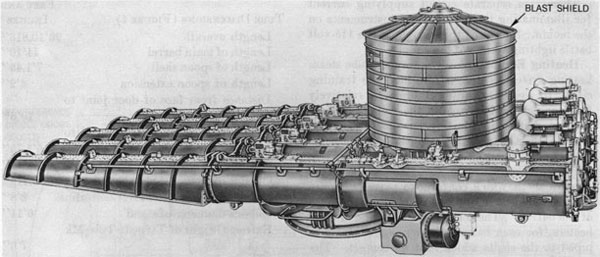
The initially planned Mark 11/12 torpedo was replaced after completion by the new and promising Mark 15 torpedo in 1938, enabling better performances overall. The ships still had a practical broadside of only eight torpedoes, the same as any European destroyer, but inferior to the IJN “special type” destroyers inaugurated by the Fubuki class in 1926.
But the admiralty worked around the “curved ahead fire” concept: Using the adjustable post-launch gyro angle and change the ship’s bearing at full speed, the two broadside could be launched nearly simultaneous, as the sixteen-torpedo spread ahead of the ship was curved arnoud to reach the same target despite starting from opposite directions. The reasoning of the dmirakty for such an heavy torpedo armament was a reflection on the post-London treaty cruisers lacking torpedoes. Eventually wartime shattered these expectations and even the Bagleys had torpedo tubes removed for more AA.
Specs, Mark 15:
Weight: 3,438 lbs. (1,55 kg) for 288 inches (7.3 meters)
Range: 6,000 yds/45 knots (5,500m/83 km/h) or 15,000 yds/26.5 knots (13,500 m/49 km/h)
Warhead: TNT Mod.3 HBX 494 lbs. (224 kg), Detonator Mk 6 Mod 13 with contact exploder
Engine: Wet-heater combustion/steam turbine, compressed air tank/Methanol
Guidance system: Gyroscope with settings (for the curve ahead fire)
AA

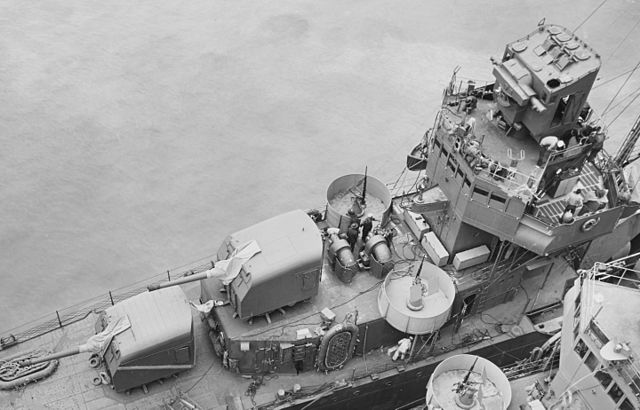
Installation of AA guns on USS Blue and Ralph Talbot
Light AA armament as designed in 1936 was pretty weak, just four .50 caliber machine guns (12.7 mm) which appeared enough to deal against 300 kph of less attack biplanes of the time. The attack on Pearl Harbor was a rude wake up call, and if it was though to equip them wth the quad 28mm/1.1 in “Chicago Piano” they caused by their weight a stability issue, as would the later 40 mm Bofors mounts. After Pearl Harbor they received one twin 40 mm Bofors (1.6 in) mount completed by six 20 mm Oerlikon cannon (0.8 in) and afgter refits in late 1944 and 1945, they had their torpedo tubes replaced by extra light AA (see later, upgrades). Overall, their AA defence was much consistent and better than the Gridleys.
ASW
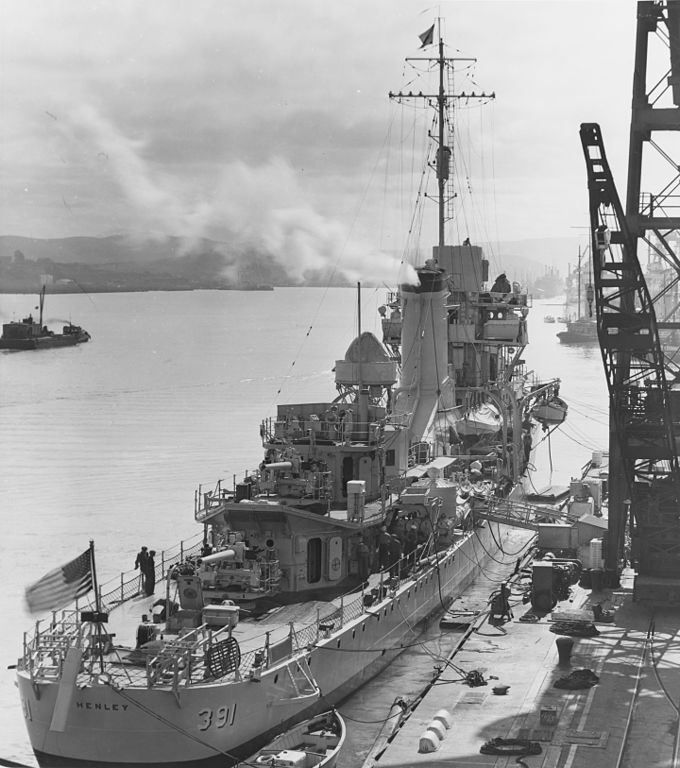
USS Henley’s stern, the two ASW racks are well visible
The Bagleys’ anti-submarine warfare (ASW) suite started with two eight-charges rolling, sloped stern depth charge racks. Later during the war they obtained four K-gun depth charge throwers either side for at least a few ships according to photos of the time.
Fire Control and sensors

Mark 33 fire control tower on top of the Bagley class USS Henley.
It was the essentially the same as the Gridley’s, with a Mark 33 open-top fire control. The Mark 33 GFCS was the US DD standard Fire Control System, coupled with the Mark 10 Rangekeeper and analog fire-control computer. This rangekeeper was mounted atop the open director, not in a separate plotting room inside the hull. Firing solutions were computed for aerial targets moving at up to 320 knots or 400 knots in a dive for AA fire.
After 1942, some had their directors enclosed, with a Mark 4 fire-control radar added atop or a Mark 4 radar enabling detection range up to 30-40,000 yards and enabling all weather detection. The Mark 33 also used tachymetric target motion prediction, however it was too slow for AA operation. The issue was solved by the introduction of the Mark 27, but it was not retrofitted on the Bagley class due to stability issues, as it was much heavier than the Mark 33.
This FCS was completed in wartime by radars and sonars, namely the:
SC Radar: The GE SC had an “A” scope, IFF connection, gyro-compass repeater link, 30-75 miles ± 200 yards accuracy later ± 100 yds on the SC-1 whereas bearing accuracy was ± 5°.
220 kW Air/Surface-search radar (VHF band/60 Hz PRF), bmw 10–25°, psw 4–5.
SG Radar: 50 KW Surface Search Frq 3 GHz PRF 775/800/825, Bmwdt 5.6°/15°, Pwdt 1.3–2 μs RPM 4/8/12, Range 15 nmi @200 yd*
Mk 12.22 Radar: Medium Wave Fire Control for Dual Purpose Batteries, goes with the Mark 37 FC Director*
QCA sonar: Early type, spherical, underwater. Manufactured by CMB. 24 cycles frequenty, M/S spherical projector, 400 Watts, electric hoist and train*
Wartime modifications
By early 1942 when permitted (generally at pearl Harbour) they all traded their four 0.5 in/90 browning HMGs for six single 20mm/70 Mk 4, placed on wings at the bridge, amidship platform and rear superstructure.
By late 1942 they obtained another extra single 20mm/70 Mk 4 and four 4 DCT or Y-Guns with a total of 44 Depth Charges (and presumably a QCA sonar at some point)
Between there and 1944, at various stages in their career for the surviving ships, they obtained a SC, SG, and Mk 12.22 radars and in 1944 at least they obtained a twin 40mm/56 Mk 1.2 Bofors gun.
By 1946 before commission, DD386, 388-390, and 392 had all their 5-in/38 Mk 30 and Mk 21 left, a twin 40mm/60 Mk 1, seven 20mm/70 MK 10, but at the cost one two of their 21-in TT banks, as well as four DCT and their two DCRs.

Old author’s profile of the Bagley, new illus awaited
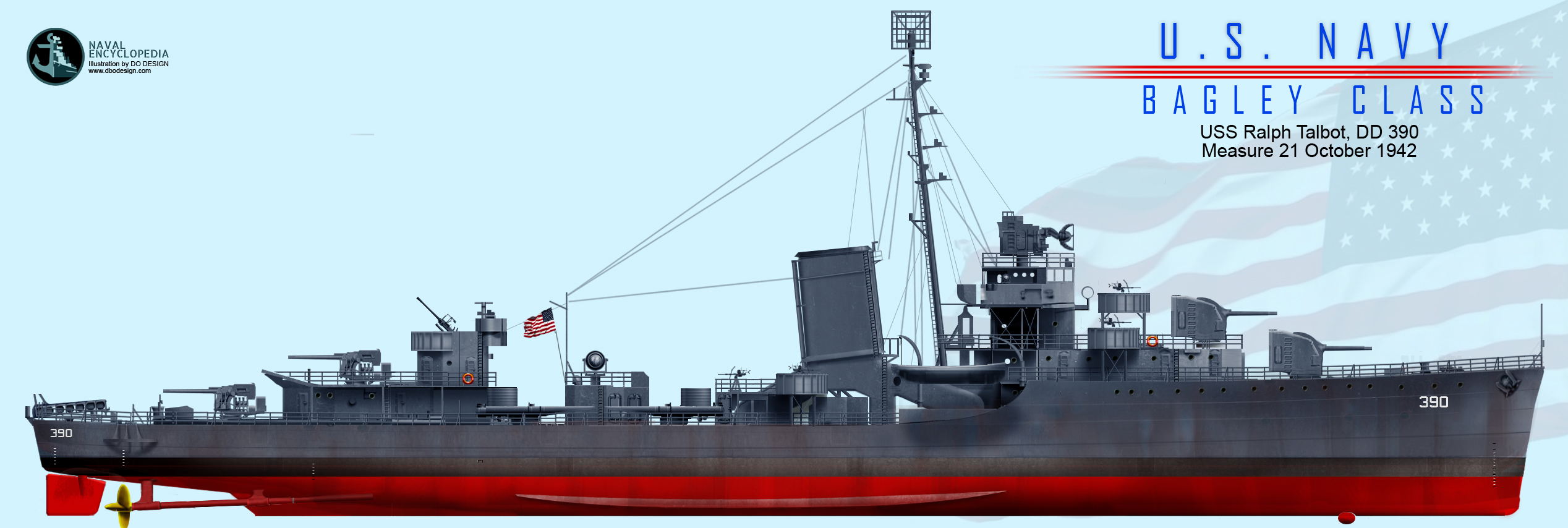
USS Ralph Talbot in Measure 21, October 1942
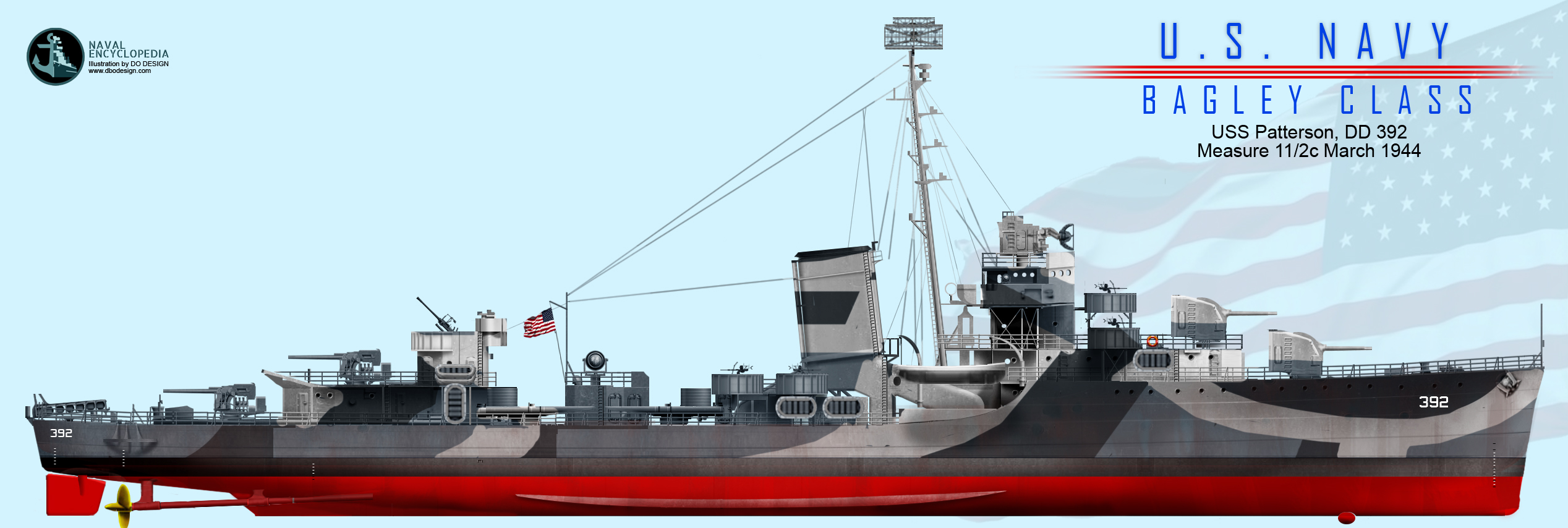
USS Patterson, Measure 31 2D, March 1944
⚙ Bagley class specifications |
|
| Displacement | 1,624 tons st, 2,245 tons full load |
| Dimensions | 341 ft 8 in x 35 ft 6 in x 12 ft 10 in (104.14 x 10.82 x 3.91 m) |
| Propulsion | 2 GE GST, 4 Babcock & Wilcox boilers 47,191 shp (35,190 kW) |
| Speed | 36.8 knots (68.2 km/h) on trials |
| Range | 6,940 nmi (12,850 km; 7,990 mi) at 12 knots (22 km/h; 14 mph) |
| Armament | 4 × 5 in/38, 4 × 0.5 HMG, 4×4 21 inch TTs, 2 DCR |
| Sensors | Sensors Mk33 GFCS, SC radar, see notes |
| Crew | 8 officers + 150 enlisted, 251 wartime |
General Assessment
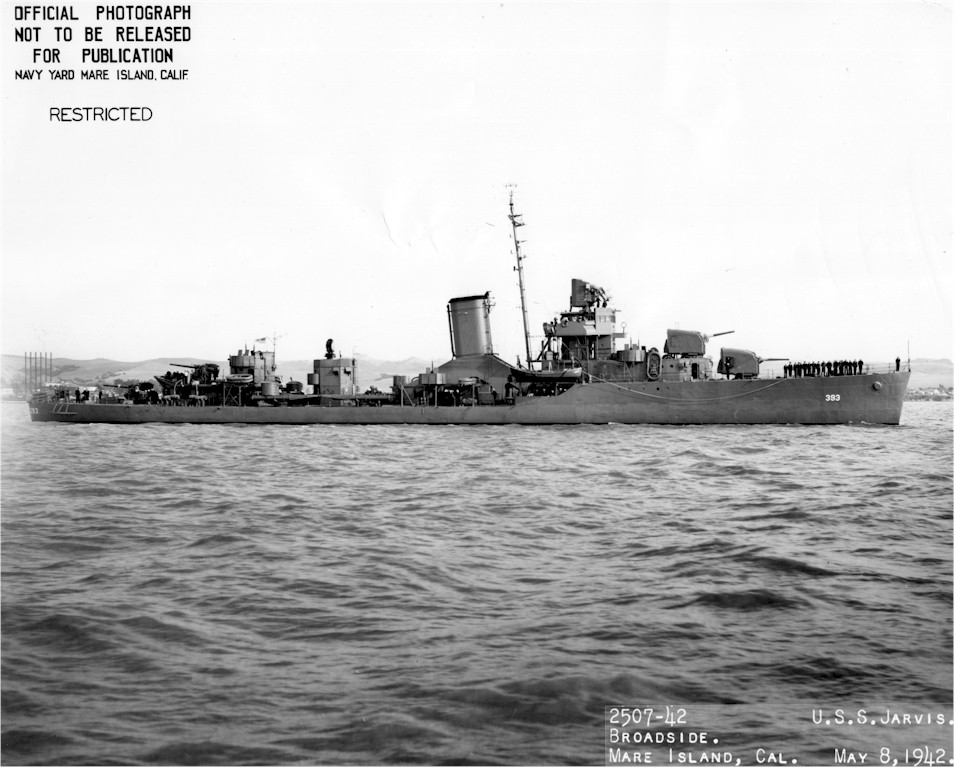
USS Jarvis in May 1942
The Bagleys were not just copy-pastes of the Gridleys. They retained the fuel-efficient power plants of the Mahan-class combined with a stronger hull giving them slightly lower speed than the Gridleys, but also the extended range of the Mahans. They repeated the typical silhouette with single stack and four main guns, with two forward enclosed mount, aft open mounts (not on the Benhams), and they were all, unlike the Gridleys away at sea, at Pearl Harbor on 7 December 1941. Their Pacific compaign was just as fierce and merciless, with Jarvis, Blue, and Henley lost in combat. In 1944 Mugford was almost lost to a kamikaze but survived thanks to her crew, being out of action for six months. Ralph Talbot shared the same fate and almost sunk off Okinawa. If Bagley, Helm, and Patterson were decommissioned in 1945, Mugford and Ralph Talbot still found som use in Operation Crossroads atomic bomb tests (Bikini atoll) as still lies, highly irradiated today, at Kwajalein.
Read More
Books
US public domain Dictionary of American Naval Fighting Ships.
Bauer, K. Jack; Roberts, Stephen S. (1991). Register of Ships of the U.S. Navy, 1775-1990 Greenwood Press.
Friedman, Norman (2004). US Destroyers: An Illustrated Design History (Revised ed.). NIP
Gardiner, Robert; Chesneau, Roger (1980). Conway’s All the World’s Fighting Ships 1922-1946. Conway Maritime Press.
Silverstone, Paul H. (1965). U.S. Warships of World War II. London: Ian Allan Ltd.
Links
history.navy.mil/ /bagley-iii.html
history.navy.mil blue-i.html
history.navy.mil/ /helm.html
history.navy.mil mugford-ii.html
history.navy.mil ralph-talbot.html
history.navy.mil henley-ii.html
history.navy.mil/ patterson-ii.html
history.navy.mil/ /jarvis-ii.html
navsource.org/archives/05/390.htm
navypedia.org/
wikipedia.org/
hazegray.org/
destroyerhistory.org 386bagley_GIBook.pdf
archive.org bagleyclass/
ibiblio.org/ FireControlInstsCh12.html
Model Kits
Main query on scalemates
Yankee Modelworks 1:350, DD-387 USS Blue Resin kit Kobo hiryu 工房飛竜 1:700, USS Patterson DD-392 (1942) Kraken Hobbies 1:700, Destroyer – Bagley/ Benham/ Gridley Class XP Forge 1:1200, USS Patterson DD-392 (1943) Iron Shipwrights 1:350. Book: USS Patterson US Navy Booklet of General Plans Navy Yard New York, Mare Island Navy Yard.
The Bagley class destroyers in service
 USS Bagley (DD386)
USS Bagley (DD386)
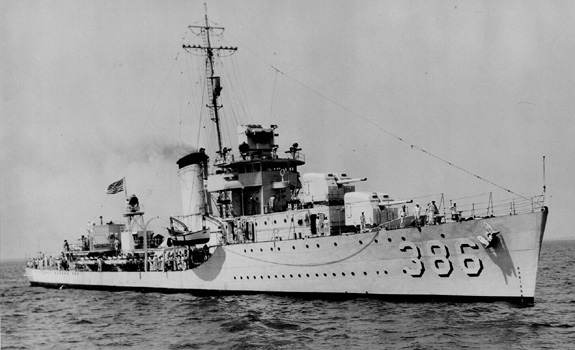
USS Bagley was commissioned on 12 June 1937 with Lieutenant Commander Earl W. Morris in command. She did her sea tria,s carribean shakedown cruise in the Caribean and training on the eastern seaboard with the Destroyer Force, Atlantic fleet, but after the war broke out she made her last western seas fleet exercizes, being sent in Pearl Harbor in 1940. She rotated through through the canal for eastern waters exercizes. By ealry December 1941, she was out of Pearl Harbor, in exercizes with DesDiv 7 and the carrier task force (USS Enterprise and Lexington). On 3 December with DesDiv 8 during an AA exercise, she had starboard side bilge keel tore loose and she crawled down to 10 knots, heading for Oahu and shifting berths in Oahu the 6th, a pivotal decision. She was on the starboard side of berth B-22, Southeast Loch, being repaired and serviced by the dock.
At 0755 on 7 December her crew first spotted the dive bombers in action over nearby Hickam Field and she went to general quarters, starting to fire her four puny .50-cal. HMGs at the B5N “Kate” passing down her port side, foing little impression. At 08:00 one of these, possibly hit by another larger AA gun, explided 30 feets ahead of her. The second attack saw her guns blazing again at 08:40, notably a group of Aichi D3A “Val” over Ford Island and the dry docks. She claimed at least six but they were probably shared. At 09:40, she made it to the channel and open sea, but without her commanding officer (CO), executive officer (XO), and gunnery officer (GO) ashore. She went on searching for the attackers out on the open sea by Lt. Philip W. Cann, and soon teamed up with Uher sister USS Patterson, but she was forced to get back after not finding anything, and patrolling the area until recalled.
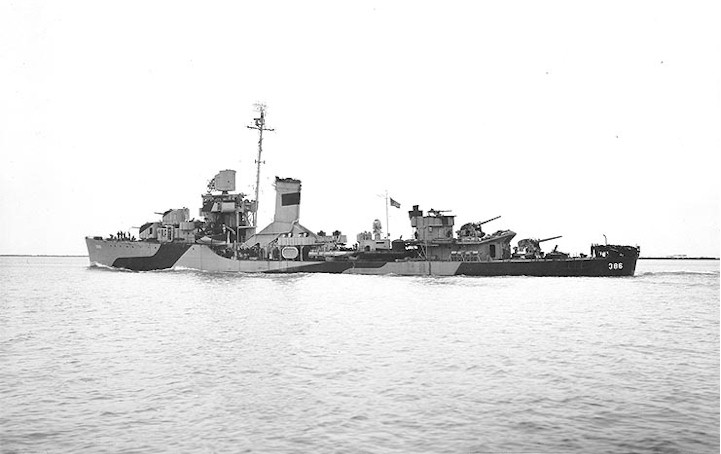
USS Bagley off Mare Island NyD in Measure 31-Design 1D
USS Bagley screened TF 14 at Pearl Harbor and was at sea with USS Saratoga, patrolling west of Oahu and covering a convoy to Samoa. On 11 January she could not prevent I-16 torpedoing Saratoga and Bagley escorted her back to Pearl Harbor, soon entering restricted availability (23 January-3 February) to received her four precious 20-mm Oerlikon AA guns.
She soon left Oahu by late January to join TF 11 with USS Lexington accompanied by four cruisers and nine destroyers for a supply run of Christmas Island, Canton Island (Phoenix Islands) as well as New Caledonia. TF 11 joined the ANZAC HMNZS Achilles and HMNZS Leander and USS Chicago, two destroyers by mid-February to prevent a Japanese attack in the sector. She headed next for Bougainville, Solomons.
On 20 February at 1707, nine IJN Mitsubishi G4M “Betty” bombers, and started barking her 20 mm battery. On of these, badly damaged and falling, heading for Bagley’s stern, but she was destroyerd ans splashed by USS Aylwin, 200 yards (200 m) of her. After Upkeep and repair in a dry dock she only left Pearl Harbor on 30 April 1942 ferrying personal to Palmyra, Christmas and Society Islands. By 9 May, off Bora Bora she met USS Hunter Liggett to escort a Convoy to the Fiji Islands on 15 May. After patrolling the area she headed for upkeep to Brisbane, Australia, reassigned to TF 44, sothwest Pacific force.
She protected convoys in and out of Australia with her sister USS Henley (DD 391) making underway night battle practice with TF 44 cruisers, until mid-July. She was in Auckland, NZ on 20 July, joining TF 62 for Operation Watchtower (invasion of Guadalcanal).
She headed for the Fiji Islands with USS Chicago, Salt Lake City, HMAS Australia, Canberra, Hobart, eight destroyers to cover 12 transports. They arrived in the Solomon and off Lunga Point, Guadalcanal, on 7 August. She became one of the “Southern Force” picket patrol ships before accompanying Australia, Canberra, and Chicago south of Tulagi. However this night an atack force of seven Japanese cruisers (Radm Gunichi Mikawa) from Rabaul fell on them. At 01:44 according to Bagley, IJN floatplanes dropped flares allowing a quick and decisive first broadside from the Japanese.
Bagley turned sharply to port to to launch her starboard torpedo tubes, but they were never aimed properly and the first four missed. In the confusion it is even possible she accidentally hit HMAS Canberra to starboard. She tried to find the Japanese but later at 03:00 she found the burning Astoria and tried to rescue survivors. This was her take on the Battle of Savo Island that famously left the Marines stranded for months at Guadalcanal with fewer supplies than expected.
USS Bagley went to shore with nearly 400 survivors from Astoria at daylight, while carying back 325 men to Astoria to fight fires and trie to patch her, but this was for nil. Her medical officer and pharmacist’s mates treated the survivors the best they could before transferred to President Jackson and she headed for Nouméa with TF 62.
On 15 March 1943, USS Bagley ws reassigned to TF 74, 7th Fleet and prepared for the New Guinea operation, departed from Townsville on 27 June 1942 with Henley and SC-749. She escorted six LSTs (2,600 Army troops and airfield equipment) to Woodlark Island. She escorted back Henry T. Allen between Milne Bay and Brisbane. She later escorted another convoy to New Guinea, Milne Bay in October and then a third convoy also from Townsville to Milne Bay, returning in December. She was in Buna on 8 November, escorting three LSTs to Finschhafen and six more convoys out of Buna. On 23 December with TU 76.1.41 to Cape Gloucester at 14:30 she had to fend a large Japanese air raid, sinking USS Brownson, damaging USS Shaw. She was back in Buna on 28 December and operated to Saidor, New Guinea. She was back on 2 January 1944.
She made another convoy mission to Saidor on 5 February and to Cape Gloucester. Afterwards she made her long trip back home for a well-deserved overhaul in San Francisco, from 27 February in eight weeks and back in operation on 5 May after training for Operation Forager (Marianas invasion). From Pearl Harbor she arrived to the Marshall Islands on 29 May, Majuro on 3 June and screeing four fast carrier task groups, and USS Bunker Hill (TG 58.2).
She then took part in the Saipan Operations in June and shortly after to the Battle of the Philippine Sea. Bagley that day fired on three planes, downing a “Val” and a “Kate” at 6,000 yards (5,000 m) astern with her main artillery as well a Zero passing at 1,000 yards (1,000 m) to her starboard.
On 25 June she was back to the Marianas for two weeks of Marine Corps artillery support, landing some 700 main gun rounds (HE as well as white phosphorus, starshell) north eof Saipan. After resupplying in July she resumed and sent 537 main rounds, even 20mm and 40mm on caverns entries aand signalled positions on the rocky hills.
She screened Enterprise during the strikes on Okinawa and Ryukyus by September, and Appari, Philippines, then Formosa.
USS Bagley took part in the Battle for Leyte Gulf but as part of Halsey’s futile pursuit force. It was over on 25 October and TG 38.4 launched attacks on Luzon five days later.
By early November in ulithi she had an overhaul from the tender USS Markab (AD-21) and returned with TU 77.4.1 for Hoggatt Bay and Tulagi. In December she trained and received repairs from USS Briareus for Operation Musketeer (the landings on Luzon) in which she took part. On 30 December, she arrived on the Palaus.
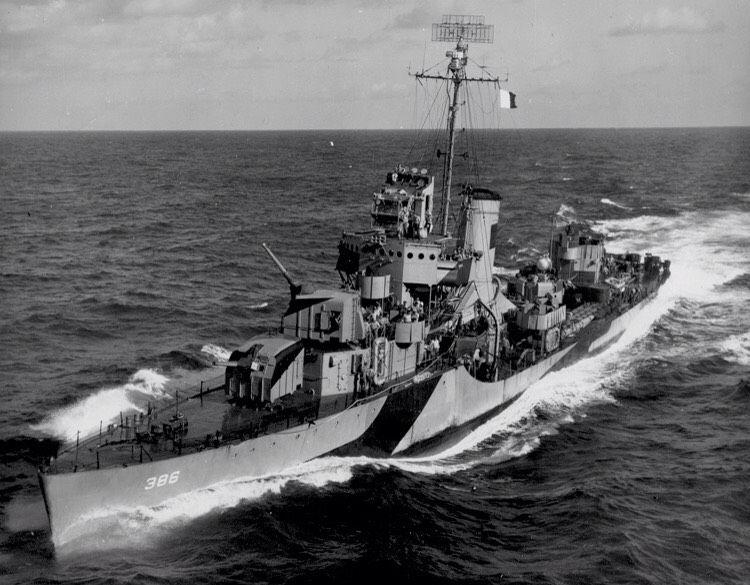
USS Bagley in February 1945
She then screened the 12 escort carriers of TG 77.2 and 77.4 with 19 other destroyers to Kossol Roads (1 January 1945) in Leyte Gulf and Mindanao Sea, Lingayen Gulf, witnessing later the destruction of USS Ommaney Bay by a Kamikaze.
She followed the TGs in the South China Sea and repelled four Japanese kamikaze raids, seeing Columbia, Manila Bay, Australia, and Stafford badly damaged. After 09:00 on the 13th, USS Salamaua wa sbadly hot, followed at 09:08 by a lone Nakajima Ki-43 “Oscar” which targeted USS Bagley. She managed to shoot her dow at 3,600 yards (3,300 m) and it crashed at 1,000 yards (1,000 m), port beam. They all retired to Ulithi (23rd) and were prepared for the landings at Iwo Jima in February.
USS Bagley was attached then to TG 52.1 and commenced operations on 25 March, screening USS Anzio until April. On 28th she followed them during a raid on Sakishima Gunto. On 24 May, she had her first generator break up, so she headed for Leyte Gulf to USS Markab for repairs.
On 15 June she departed for Kerama Retto and TG 32.1 during striked on Okinawa. Her main battery director failed and she retired to join USS Yosemite and then moved to Saipan on 5 July, Apra harbor, having a new director installed on 14 July. She was back to Saipan on the 15th and on the 6 August escorted a convoy to Okinawa. After the end of the war, she headed for Saipan, resting for 10 days and visited by Rear Admiral Francis E. M. Whiting and staff. She carried them to Marcus Island (31) for a surrender ceremony on board of Rear Admiral Matsubara Masata.
Returning to Saipan on 2 September, she reported to the 5th Fleet commander for orders, and sailed to Okinawa, and to Japan, Sasebo (20 September) actiing a minefield marker between Sasebo, Nagasaki, and Wakayama.
She left Sasebo on 29 October for home via Pearl Harbor, to San Diego on 19 November. Not chosen for the Bikini Atoll while back in Pearl Harbor by April 1946 she was inactivated on 2 May, decommissioned on 13 June and towed to San Diego for sale. Stricken on 25 February 1947 she was sold for BU on 8 September 1947. For her service she earned 12 battle stars.
 USS Blue (DD387)
USS Blue (DD387)
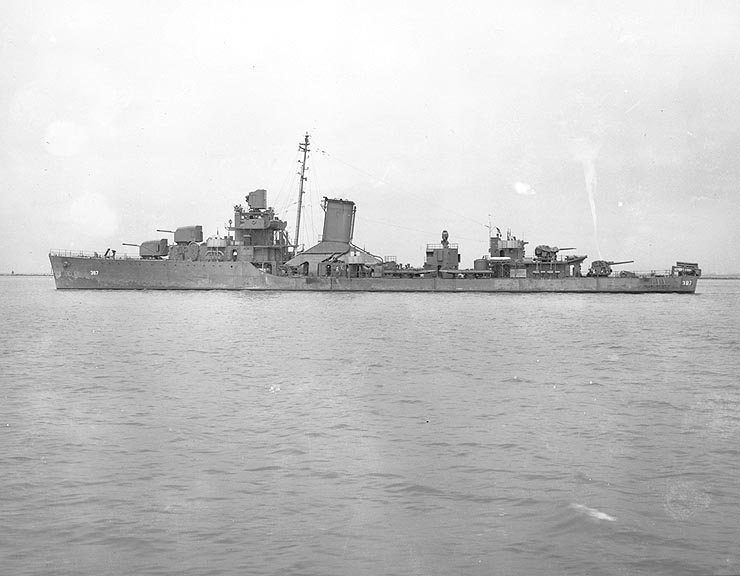
USS Blue in … ocean blue livery (measure xx) off Mare Island Navy Yard, California, 11 April 1942.
Commissioned on 15 August 1937 (she was launched in May), she spend the rest of the year in sea tria,s and shakedown, training cruises along the east coast and Caribbean. USS Blue when declared ready was assigned to the Pacific in August 1938 (a year after) and became flagship Desdiv 7, Desron 4, training with the Battle Fleet along the west coast. From April 1940 she was sent to Pearl Harbor. She returned home for an overhaul at Puget Sound in February–March 1941 and trained in April, and was in Pearl Harbor on 7 December 1941. Unlike larger ships she was able to quickly raise steam and sail out, in search of the Japanese fleet, without her staff but just four ensigns on board. She was part of the offshore patrol until early January 1942.
She was assigned to the screening of USS Enterprise for the raids on Wotje, Maloelap, Kwajalein Atolls, and the Marshall Islands. On the 24th of February she took part in the Wake Island attack and by March–June 1942 she escorted convoys between Pearl Harbor and San Francisco and proceeded to Wellington in New Zealand (18 July).
Assigned TG 62.2 she was present at the Battle of Guadalcanal on 7 August providing fire-support and screening and also at the Battle of Savo Island on the 9th, helping rescuing the crews from HMAS Canberra. She patrolled of Nouméa, New Caledonia on 13-17 August and returned to Guadalcanal on the 21th. But at 03:59 the following day while underway in the “Ironbottom Sound” she was spotted and torpedoed by the Japanese destroyer IJN Kawakaze. Her main engines were quickly flooded, her shafts deviated, her steering gear jammed and she had nine men killed, 21 wounded in the explision. Despite her crew’s effort she was doomed and on 23 August an attempted towing to Tulagi failed. Her captain decided to have her scuttled at 22:21, on 23 August. Despite her short career she nevertheless managed to earn five battle stars.
 USS Helm (DD388)
USS Helm (DD388)
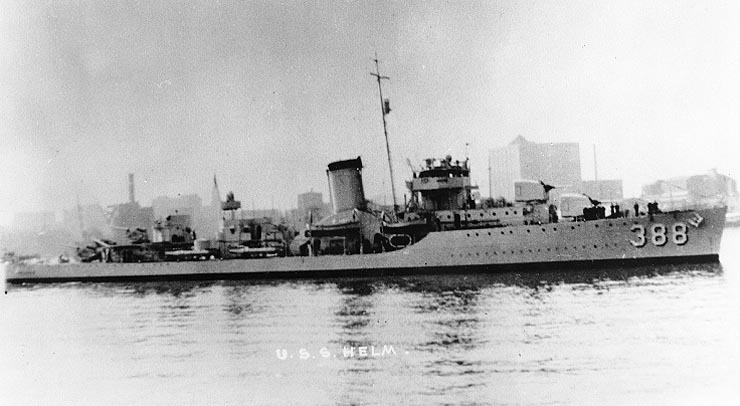
USS Helm prewar
USS Helm was commissioned on 16 October 1937, her first captain being Lt. Comdr. P. H. Talbot. After sea trials and shakedown, in march 1938 she was found training in the Caribbean and was attacjed to the Atlantic Squadron from 1 October 1938 and in 1939 was assigned to the Carrier Division 2 (CarDiv 2) for Problem XX. In May 1939 she moved to San Diego for the Pacific fleet screeing maneuvers and sailed to Hawaii. She was there during the attack on 7 December.
When the first raid commenced USS Helm was at West Loch, en route to deperming buoys and became the only ship underway this week end. General quarters were ordered and she managed to down one plane, although slightly damaged by bombs near-misses. At 08:17 she left West Loch Channel, rushed to the Pearl Harbor Inlet when a lookout spotted the midget sub HA. 19 snagged on a reef. She shot it and missed and saw the two crewman fleeing, one drowning, the other made POW, the very first of WW2. Next, she was assigned to USS Saratoga arrived from San Diego.
On 20 January 1942 she rescued Department of the Interior workers from Howland and Baker islands using her whaleboats. Later this day she was attacked but missed by an IJN patrol bomber. She was back in Pearl on 6 February.
New Hebrides: She departed on 15 March 1942, to escort the advance base party there, Efate on 19 March and escorted the ships back. She rescued survivors from SS John Adams later from the oiler Neosho sunk at the Battle of Coral Sea on 17 May. These men were taken to Brisbane, Australia, where Helm joined the Australian-US Task Force 44, under Rear Admiral Victor Crutchley, on 19 May. For two months she patrolled off the Australian Coast. On 22 July she operated at the Fiji Islands. Next in August, Guadalcanal and Tulagi, managing to shoot down several attacking aircraft durinf the landings.
Next, she was present at the Battle of Savo Island screening USS Vincennes, Quincy, and Astoria in the night of 7-8 August her sisters Blue and Ralph Talbot stationed as picket northwest of Savo Island. Alarm was sounded by USS Patterson, HMAS Canberra was quickly torpedoed, and later Helm assisted the burning Astoria and withdrawn to Nouméa. A few weeks of escort to Guadalcanal followed, based in Australia. She also escorted convoys to New Guinea.
On 15 May 1943 she rescued the crew of the hospital ship Centaur sunk by I-177 off Brisbane. She escorted an LST for a landing in June 1943 and protected Milne Bay. She bombarded Gasmata on 29 November and sortied on 14 December (Admiral Crutchley) for the operation on Cape Gloucester. Next she was in Saidor for Admiral Barbey amphibious “hops.” and screening the cruiser force
By 1944 she was still off Guadalcanal and Milne Bay and on 19 February 1944 went back to Pearl Harbor and then Mare Island escorting USS Maryland, on 4 March. She left San Francisco on 5 May 1944 for a refresher training underwya to Pearl Harbor and made it to Majuro on 4 June, then Kwajalein to take part in the invasion of the Marianas with TF 58, departing Kwajalein on 7 June.
She provided air support for the landings and was back to the Bonin Islands on 18 June and took part on 19 June to the Battle of the Philippines.
She operated to the Bonin and Volcano Islands and the invasion of Guam, followed by the Palau Islands on 25 July 1944, with resupplies at Eniwetok or Ulithi. In 24 September she sortied again for strikes in the Palaus, Okinawa (10 October) and Formosa. USS Helm claimed a bomber on 13 October and assisted more.
On 24 October the assault on Leyte, and following this the Japanese attacked. She was screening the carrier groups northwards after the decoy fleet of Admiral Ozawa.
Helm later provided direct support for the landings on 26 October. With USS Gridley she sank 1-46. She was back in Ulithi on 2 November.
She took part in the next landings in the Philippines and screening new air strikes but was detached from TG 38.4 for Manus, being prepared for the landings at Lingayen Gulf, Luzon. In Sulu Sea, she helped repelling heavy air attacks up to 23 January, and she left for Ulithi.
Next she was prepared for the invasion of Iwo Jima, sailing out on 12 February, and starting operations on the 19th. She rescued survivors of USS Bismarck Sea sunk on 21 February. Operations went on until 7 March and she went to Leyte for repairs. Next she took part in the invasion of Okinawa from 27 March, and assisting troops on 1 April in fire support operations. She also shot down many Kamikaze and left on 19 June.
Later in 3-6 August she searched for USS Indianapolis survivors. She was returning to Ulithi on 15 August. Back to Okinawa and Iwo Jima she joined the Bonins patrol, a rescue team until 8 September. She was in Sasebo as shipping guide and patrol vessel and departed for Pearl Harbor and San Diego in late October and arrived in November.
She was decommissioned in Pearl Harbor on 26 June 1946, stricken and sold for BU on October 1947. She earned 11 Battle stars.
 USS Mugford (DD389)
USS Mugford (DD389)
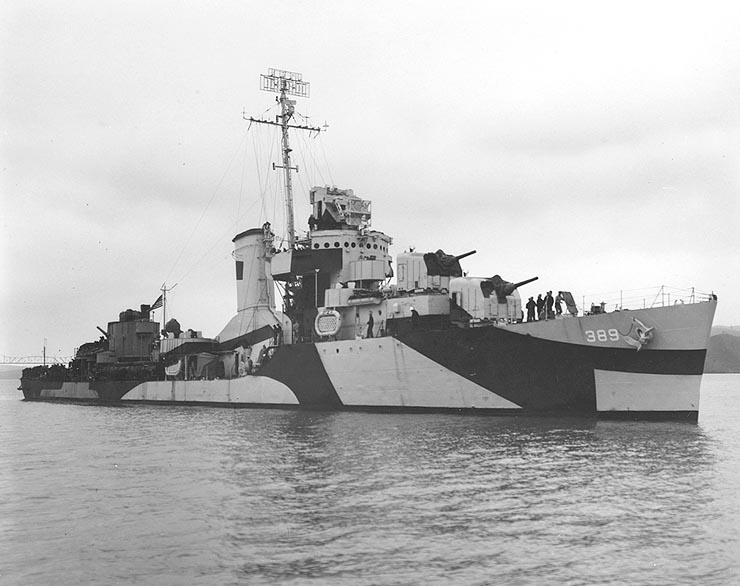
USS Mugford in 1944
USS Mugford, laid down in 1935 was commissioned on 16 August 1937. After sea trials and Carribean shakedown, she skipped fleet training on the east coast and went directly to the Pacific by late 1937. She trained between West Coast and around the Hawaiian chain, alternated with upkeep. Until 30 July 1940 she was under command of Lt. Cdr Arleigh Burke (yes, this one) being awared a Battle “E” for gunnery excellence.
On 7 December 1941 she was present at Pearl Harbor as flagship DesDiv 8, DesRon 4. She was berthed at B6, Navy Yard for ovehaul and the presonal present managed to raise steam to get underway. Her gun crew managed to shoot down three planes in 10 minutes and she steamed out of Pearl Harbor to search for the Japanese. Later she was in the Wake Island relief force and later was an escort from Australia until mid‑1942.
On 7 August USS Mugford while off Lunga Point, Guadalcanal she took three near misses and one hit. She shot down two attackers, but suffered 8 killed, 17 wounded, 10 missing. She shot down another on the 8yh, and rescued two enemy aviators. On the 9th, she made a run to join the first Battle of Savo Island, and rescued 400 survivors from USS Vincennes and Astoria.
After repairs in Sydney, in September-December, she operated in the Coral Sea and and northern coast of Australia from Brisbane. She also escorted ships to Milne Bay in New Guinea, took part in the attack on Woodlark Island and bombarded objectives in August. By September she escorted LSTs for the invasion of Lae and took part in the preinvasion bombardment of Finschafen. On 20 October she was attacked by 60 enemy planes, shot down some and survived.
On 15 May 1943 she rescued survivors of AHS Centaur off Queensland and by 14-15 December took part in the Landings on Arawe in New Britain followed by the attacks on Buna and Cape Gloucester. While off on the 25th she was heavily attacked by enemy raid, taking three near misses, shooting one during the second attack, and having one killed, six wounded, widespread damaged and waterline holed. She had some repairs in Milne Bay, and returned operating off Saidor. On 10 January 1944 she had full repairs in Sydney and resumed operation in New Guinea, with Huon Gulf and escorting ships to Union Islands. She was back in Pearl Harbor on 24 February, escorting USS Maryland to Puget Sound and being overhauled at Mare Island from 5 March until 10 May.
Back to Pearl Harbor she trained for the Marianas operation, starting with the attack on Majuro on 11 June, and she screened battleships bombarding Saipan and Tinian, returned to the carrier screen for the Battle of the Philippine Sea. Next she operated in the Marshalls, invasion of Guam (she acted as radar picket between there and Rota). On 28 August with TF 38 she screened carriers during the attacks on the Bonins, Yap, and Palau, Okinawa, Formosa and Luzon. She claimed downing many attackers all this time.
Assigned to TG 38.4 on 24 October she headed north on reports of an attack on northern Luzon and was present at the Battle off Cape Engaño ending the Battle of Leyte Gulf. On 5 December 1944 she spotted enemy aircraft in Surigao Strait and downed a “Val”. Badly damaged herself she had 8 killed, 14 wounded and received temporary repairs before heading for San Pedro and then the US for permanent repairs at Mare Island, from 5 January 1945 to 4 March 1945.
Back on mid‑March, she served as radar picket between Ulithi and Saipan and after the war, sailed with TG 55.7 to repatriated Allied POWs from Japan to Okinawa and screen carriers during the occupation of Nagasaki‑Sasebo; She headed for San Diego on 19 November, was stripped and designated for Operation Crossroads, decommissioned 29 August 1946. After the blast in Bikini she served for experiments in decontamination, and was sunk off Kwajalein 22 March 1948. She received 7 battle stars for her service.
 USS Ralph Talbot (DD390)
USS Ralph Talbot (DD390)

Ralph Talbot in Hawaiian waters, circa January 1943.
USS Ralph Talbot (DD-390) named after USMC 2nd Lt. Ralph Talbot (1897–1918) awarded the MoH in World War I. Commissioned on 14 October 1937, she soldiered in the Pacific from Pearl Harbor attack to the Battle of Okinawa. She notably participated to the Battle of Savo Island with Task Group 62.6 (TG 62.6), took part in the Battle of Kolombangara, New Georgia and New Guinea campaigns, Bismarck Archipelago, Marianas, West Caroline, Leyte, Luzon, Iwo Jima and Okinawa, earning 14 battle stars. She ended contaminated at Operation Crossroads in Bikini, August 1946.
 USS Henley (DD391)
USS Henley (DD391)
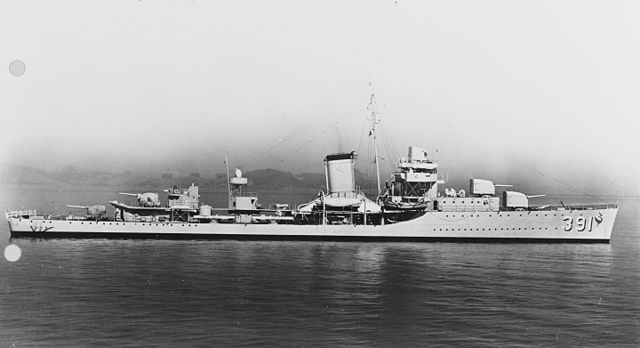
Second ship named after Captain Robert Henley, officer in the young USN during the Quasi-War with France, War of 1812 and Second Barbary War, USS Henley was commissioned on 14 August 1937. Her career was shorter than her sisters. She started operations with DesDiv 11 by late 1938 and sailed to Pearl Harbor on 14 April 1941. On 7 December 1941 she was moored in East Loch, being the first destroyer to shoot the initial wave. She claimed a “Val” and shared another. and later attacked a midget sub outside the harbor. Next she escorted ships to Midway but spent most of 1942 in ASW mostly in Australian waters. She took part in the battle of Guadalcanal.
She met her fate while off the beachhead at Finschafen in New Guinea on 21 September 1943: The 10 Japanese torpedo bombers attack was repelled, as she shoot down, 3 assisted 3 more, but on 3 October with USS Reid and Smith she sighted two torpedoes from Ro-108, she evade these but was struck by a third, too fast to be avoided. Her port side, blew up and she lost her keel. At 18:29 she was evacuated and later she sank stern first, loosing 1 officer and 14 men. She earned 4 battle stars.
 USS Patterson (DD392)
USS Patterson (DD392)

She was named after Daniel Todd Patterson, a very early USN history figure. Commissioned 22 September 1937 she was soon sent to the Pacific, Pearl Harbor from On 3 June 1940. Present on 7 December she was one of the first to fire and sally out in search of the enemy. She fought notably at Guadalcanal, the Battle of Savo Island, lost her bow during the New Hebrides campaign, and escorted the fast carrier force during all their operations in 1944-45, earning 14 battle stars. She was decommissioned on 8 November 1945, stricken on 25 February 1947 and sold.
 USS Jarvis (DD393)
USS Jarvis (DD393)
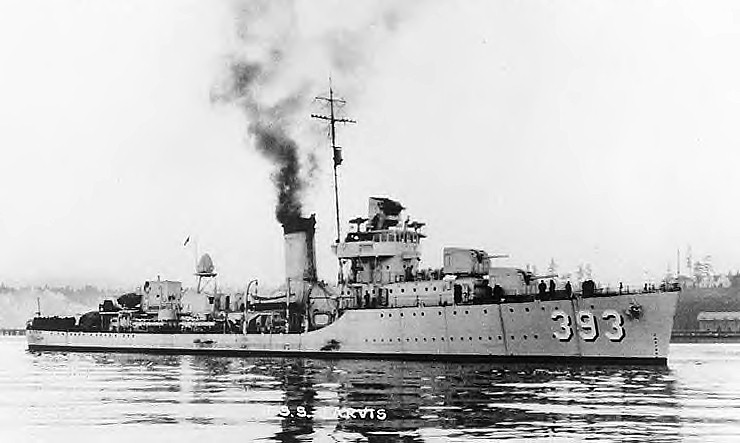
Jarvis December 1937
Named aft midshipman James C. Jarvis, killed during the Quasi-War with France she saw heavy action in the early Pacific campaign, notably participating in the invasion of Guadalcanal. She was sunk to the south of Guadalcanal on 9 August 1942 with all hands, a rare case. She was hit by an aicraft torpedo off Savo Island, was save by her crew abd underway under her own power bu the Japanese mistaking her for an escaping cruiser sent an attack of 31 planes from Rabaul. Overwhelms she was soon hit by several torpedoes and according to Japanese records, “split and sank” this 9 August 1942. She earned 3 battle stars.

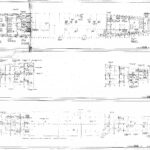
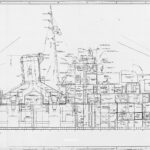
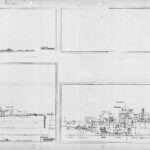
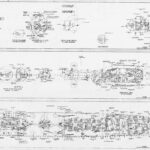
 Latest Facebook Entry -
Latest Facebook Entry -  X(Tweeter) Naval Encyclopedia's deck archive
X(Tweeter) Naval Encyclopedia's deck archive Instagram (@navalencyc)
Instagram (@navalencyc)





 French Navy
French Navy Royal Navy
Royal Navy Russian Navy
Russian Navy Armada Espanola
Armada Espanola Austrian Navy
Austrian Navy K.u.K. Kriegsmarine
K.u.K. Kriegsmarine Dansk Marine
Dansk Marine Nautiko Hellenon
Nautiko Hellenon Koninklije Marine 1870
Koninklije Marine 1870 Marinha do Brasil
Marinha do Brasil Osmanlı Donanması
Osmanlı Donanması Marina Do Peru
Marina Do Peru Marinha do Portugal
Marinha do Portugal Regia Marina 1870
Regia Marina 1870 Nihhon Kaigun 1870
Nihhon Kaigun 1870 Preußische Marine 1870
Preußische Marine 1870 Russkiy Flot 1870
Russkiy Flot 1870 Svenska marinen
Svenska marinen Søværnet
Søværnet Union Navy
Union Navy Confederate Navy
Confederate Navy Armada de Argentina
Armada de Argentina Imperial Chinese Navy
Imperial Chinese Navy Marinha do Portugal
Marinha do Portugal Mexico
Mexico Kaiserliche Marine
Kaiserliche Marine 1898 US Navy
1898 US Navy Sovietskiy Flot
Sovietskiy Flot Royal Canadian Navy
Royal Canadian Navy Royal Australian Navy
Royal Australian Navy RNZN Fleet
RNZN Fleet Chinese Navy 1937
Chinese Navy 1937 Kriegsmarine
Kriegsmarine Chilean Navy
Chilean Navy Danish Navy
Danish Navy Finnish Navy
Finnish Navy Hellenic Navy
Hellenic Navy Polish Navy
Polish Navy Romanian Navy
Romanian Navy Turkish Navy
Turkish Navy Royal Yugoslav Navy
Royal Yugoslav Navy Royal Thai Navy
Royal Thai Navy Minor Navies
Minor Navies Albania
Albania Austria
Austria Belgium
Belgium Columbia
Columbia Costa Rica
Costa Rica Cuba
Cuba Czechoslovakia
Czechoslovakia Dominican Republic
Dominican Republic Haiti
Haiti Hungary
Hungary Honduras
Honduras Estonia
Estonia Iceland
Iceland Eire
Eire Equador
Equador Iran
Iran Iraq
Iraq Latvia
Latvia Liberia
Liberia Lithuania
Lithuania Mandchukuo
Mandchukuo Morocco
Morocco Nicaragua
Nicaragua Persia
Persia San Salvador
San Salvador Sarawak
Sarawak Uruguay
Uruguay Venezuela
Venezuela Zanzibar
Zanzibar Warsaw Pact Navies
Warsaw Pact Navies Bulgaria
Bulgaria Hungary
Hungary

 Bundesmarine
Bundesmarine Dutch Navy
Dutch Navy Hellenic Navy
Hellenic Navy Marina Militare
Marina Militare Yugoslav Navy
Yugoslav Navy Chinese Navy
Chinese Navy Indian Navy
Indian Navy Indonesian Navy
Indonesian Navy JMSDF
JMSDF North Korean Navy
North Korean Navy Pakistani Navy
Pakistani Navy Philippines Navy
Philippines Navy ROKN
ROKN Rep. of Singapore Navy
Rep. of Singapore Navy Taiwanese Navy
Taiwanese Navy IDF Navy
IDF Navy Saudi Navy
Saudi Navy Royal New Zealand Navy
Royal New Zealand Navy Egyptian Navy
Egyptian Navy South African Navy
South African Navy






























 Ukrainian Navy
Ukrainian Navy dbodesign
dbodesign